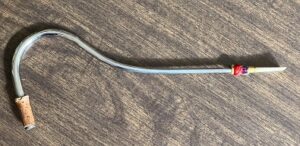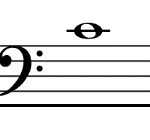
Pitch
Playing the reed on the bocal should produce a concert middle C.

- Take your bocal out of the case.
- Hold your reed at the wrapped end.
- Center the opening of the reed tube on the hole at the smaller end of the bocal.
- Gently twist the reed onto the bocal.
- Play middle C on the piano to get the pitch in your ear.
- Sing the middle C with the piano.
- Stop singing but keep hearing the C.
- Play the reed on the bocal and try to match the middle C.
Tips:
If your pitch is LOWER than middle C:
- Make sure to hold the bocal so the cork end is the same height as the reed.
- Blow more and/or faster air.
- Put a little more of the reed blade in your mouth.
- Raise the back of your tongue as if saying “bee”.
- Decrease the amount of space between your teeth.
- Increase the hug with your lips while keeping some space between your teeth.
If your pitch is HIGHER than middle C:
- Make sure to hold the bocal so the cork end is the same height as the reed.
- Maintain adequate air flow for a full sound.
- Increase the amount of space between your teeth.
- Lower the back of the tongue as if saying “aaah”
- Increase space in the oral cavity as if you just took a bite of very hot pizza. (“Hot pizza mouth”)
Practice matching pitch on these whole notes with a drone on C
Sustained Whole Notes
This exercise addresses sustaining notes at the same pitch level.
- Create your aural target. (Listen to the first bar of the drone to get your ears tuned to the pitch you’re aiming to match.)
- Exhale on beats 1-2.
- Inhale on beats 3-4.
- Articulate beat one of each bar.
- Sustain a supported air stream for 16 beats.
- See Tips above for reminders of what to adjust if your pitch is higher than or lower than the drone.

Things to Notice
As you play the sustained C whole notes, pay attention to the following:
- Is your pitch staying steady? If not, how does it change?
- Does the pitch change when you articulate? If yes,
- Move only the front of your tongue and move it as little as possible.
- Maintain air & breath support, especially at the end of each bar.
- Is the back of your tongue moving/changing? If yes, work to move only the tip of your tongue when articulating.
- Does the space in your oral cavity (inside your mouth) change as you sustain each note?
- Does the pressure from your lips change as you sustain each note?
Rhythms
This exercise adds more articulation.
- Create your aural target. (Listen to the first bar of the drone to get your ears tuned to the pitch you’re aiming to match.)
- Exhale on beats 1-2.
- Inhale on beats 3-4.
- Articulate the rhythm pattern while keeping your air steady.
- Sustain a supported air stream for 16 beats.
- See Tips above for reminders of what to adjust if your pitch is higher than or lower than the drone.

Focus on matching pitch with the drone the first time through the exercise.
On the repeat, keep listening to the drone but shift your primary focus to clarity and accuracy of your articulation.
If the articulation is fuzzy or muddy sounding:
- Move your point of contact closer to the tip of your tongue.
- Flick the reed with a quicker motion.
- Make sure your tongue is contacting the reed (not the roof of your mouth).
- Blow a constant and supported air stream.
Improvise
Play rhythms on the reed and bocal while paying attention to intonation and clarity of articulation.


Feedback/Errata